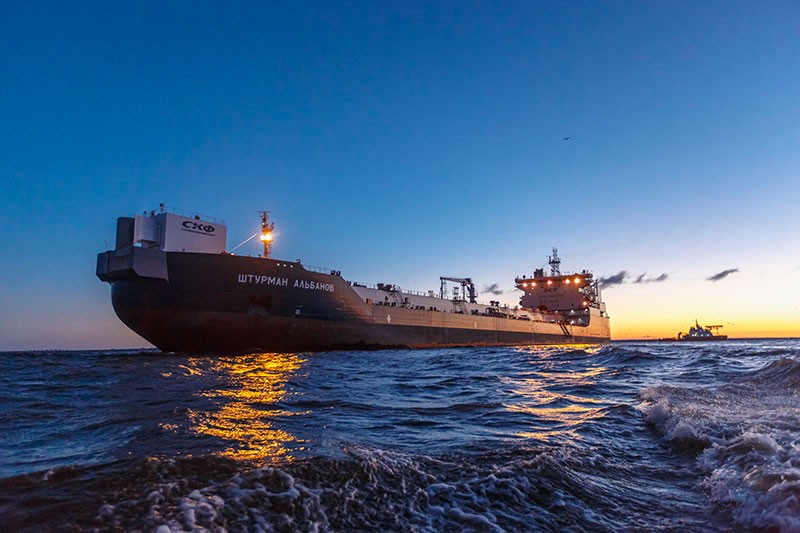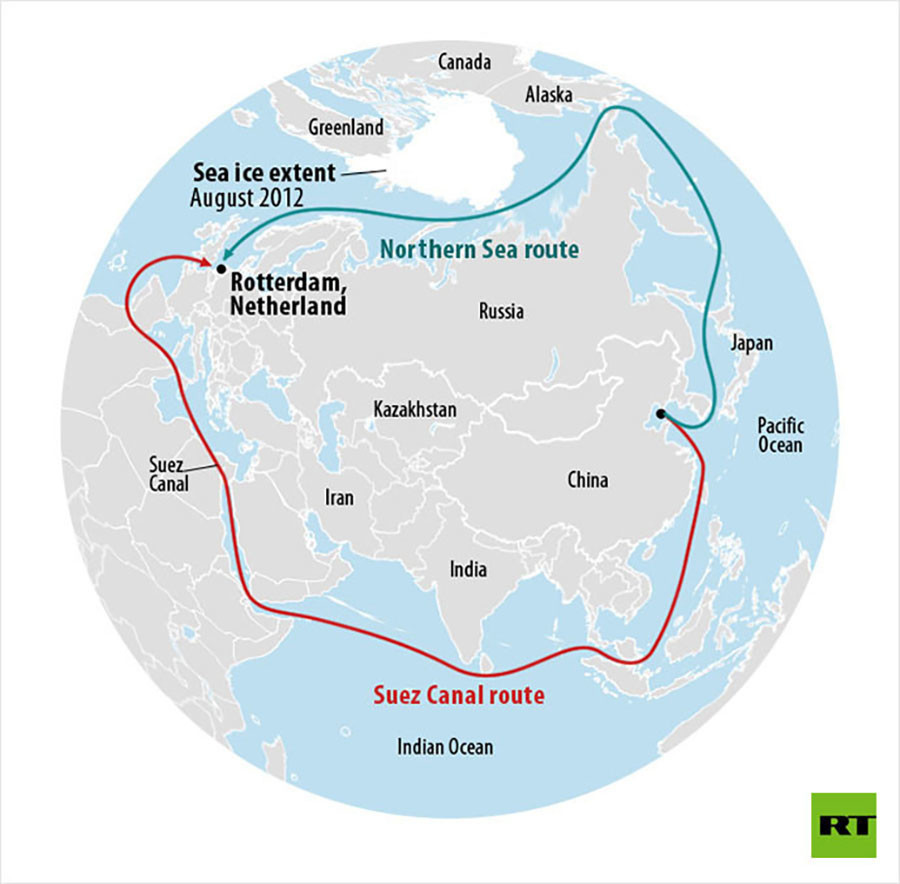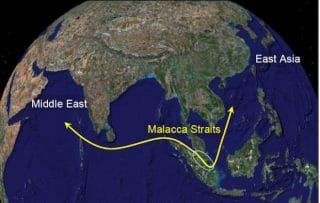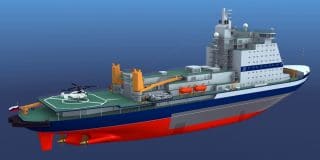
The Northern Sea Route is completely ice-free and shipping thrives
Russia is engaged in an aggressive one-sided arms race in the Arctic which is being IGNORED by NATO, warns report as relations with the West continue to frost
- The true scale of Russia's Arctic militarisation has been revealed in a new study
- Despite the UK warning NATO to interview, Russia is continuing its expansion
- Russia has established a new military district in the Arctic and expanded forces
- The country even launched a rocket with a satellite on board earlier this year
Russia has been expanding its military activities in the Arctic by establishing a military district, increasing training, and creating new brigades in the area, a new report reveals.
The true scale of Russia's Arctic militarization since 2014 has been revealed in a paper from The Henry Jackson Society's Russia Studies Centre.
Despite the UK urgently requesting NATO to intervene and warning of a possible second Cold War, Russia is continuing to militarise and exploit the region's natural resources.
The Huge Implications of Russia’s Northern Sea Route
I mention the partners to emphasize once again how US sanctions have boomeranged on US long term interests. By cutting off access to Western funding for development projects, China, and even US allies South Korea and Japan were quick to move in.
Rather than cripple the projects as the US wanted, they are in a stronger position than they would have been with Western funding, and in multiple ways.
China’s plan of letting others buy into the Silk Road assures it of long term support. And the new Northern Arctic route provides “alternate” shipping security in case a choke point were to develop along the land ones, such as in the case when Ukraine attempted to extort Moscow on its gas pipeline exports.

The Northern Sea Route is expected to become a major trade route for goods shipped between Europe and Asia. It stretches the entire length of Russia's Arctic and Far East regions.
“The corresponding bill is currently being considered in the State Duma. I expect that it will be adopted soon,” said Putin, adding there are proposals to extend the rule to other maritime areas of the country. “Let's analyze all these questions thoroughly and without haste,” he added.

The amount of cargo transported via the Northern Sea Route exceeded the Soviet record last year, at 7.5 million tons. According to estimates from the Federal Agency for Maritime and River Transport, it could grow sixfold in the next three years. By 2030 the volume is expected to skyrocket to 70 million tons.
Ships will mainly transport liquefied natural gas (LNG), oil, and coal. The Arctic route from Southeast Asia to Europe cuts the transportation time in half compared to traditional routes through the Suez and Panama canals. In Soviet times, it was used mainly to supply goods to isolated settlements in the Arctic.
The new sea route goes through Russian exclusive economic zones; although the US Navy may be able to threaten the southern routes to and from China, this northern back door will not only be a viable option, but one that is easily defended.
The cherry on top will be that oil and gas, plus other mineral exports along the shore route, will have export transportation facilities along the route. And, with Russia leading the way with their nuclear icebreakers, the Russians will have a monopoly on that market for some time.
As VT has editorialized since the beginning, the US sanctions caused Moscow some pain, but as is happening with Iran, they will be coming out of it stronger in the long run.
And what is the Trump answer to all this? So far it has been the usual huffing and puffing of a grandiose US infrastructure program, all debt-funded, of course. You just can’t make this stuff up
In terms of dealing with some of the world’s harshest weather conditions no country comes close compared with Russia. Now Russia has made it a highest priority to develop a Northern Sea Route along the Russian Arctic coast to enable LNG and container freight shipments between Asia and Europe that will cut shipping time almost in half and bypass the increasingly risky Suez Canal.

China is fully engaged and has now formally incorporated it into its new Silk Road Belt, Road Initiative infrastructure.
Before attending the Hamburg G20 Summit in July, China’s President Xi Jinping made a stopover in Moscow where he and Russia’s President Vladimir Putin signed the “China-Russia Joint Declaration on Further Strengthening Comprehensive, Strategic and Cooperative Partnership.”
The declaration includes the Northern Sea Route as a strategic area of cooperation between China and Russia, as a formal part of China’s Belt, Road Initiative (BRI) infrastructure. For its part, Russia is investing major resources in development of new LNG ports and infrastructure along the route to service a growing maritime traffic passing through its Arctic territorial waters.
The Russian Federation, under the direct supervision of President Putin is building up the economic infrastructure that will create an alternative to the Suez Canal for container and LNG shipping between Europe and Asia.
In addition, the developments are opening up huge new undeveloped resources including oil, gas, diamonds and other minerals along the Russian Exclusive Economic Zone,transversing its northernmost Siberian coastline.
Officially Russian legislation defines the Northern Sea Route as the territorial waters along the Russian Arctic coast east of Novaya Zemlya in Russia’s Arkhangelsk Oblast, from the Kara Sea across Siberia, to the Bering Strait that runs between far eastern Russia and Alaska. The entire route lies in Arctic waters and within Russia’s Exclusive Economic Zone (EEZ).
Preliminary geophysical studies confirm that vast oil and gas reserves exist below the sea floor along the Northern Sea Route of Russia’s EEZ waters, increasing interest of the Chinese government in joint resource development with Russia, in addition to the potentially shorter shipping times to and from Europe.

For China, which sees increasing threats to its oil supply lines by sea from the Persian Gulf and via the Straits of Malacca, the Russian Northern Sea Route offers a far more secure alternative, a Plan B, in event of US Naval interdiction of the Malacca Straits.
US Geological Survey estimates are that within the Russian Arctic EEZ some 30% of all Arctic recoverable oil and 66% of its total natural gas is to be found. The USGS estimates total Arctic oil recoverable reserves to be about one-third total Saudi reserves. In short, as Mark Twain might have said, there’s “black gold in them thar’ icy waters…”
The United Nations Convention on Law of the Seas (UNCLOS), to which Russia and China are signatories, but the USA not, defines an exclusive economic zone to be an area “beyond and adjacent” to a state’s territorial waters and provides the state with “sovereign rights…[over] managing the natural resources” within the zone.
China does not contest Russia’s EEZ rights, but rather seeks to cooperate in its development now formally within the BRI project.
New Shipping Lanes
The other interest in Russia’s Northern Sea Route is for more economical and faster shipping. In August this year, in a test run the Russian LNG tanker, Christophe de Margerie, delivered Norwegian LNG from Hammerfest in Norway to Boryeong in South Korea in just 19 days, some 30% faster than the traditional Suez Canal route despite the fact that the vessel was forced to go through ice fields 1.2 meters thick. The Arctic Sea part of the journey was made in a record six and half days.
The Christophe de Margerie is the first joint LNG tanker and icebreaker in the world, built to specification for the state-run Sovcomflot for the transportation of LNG from the Yamal LNG project in the Russian Arctic by a South Korean shipbuilder.

Russia is also cooperating with South Korea in development of the shipping capabilities of its Northern Sea Route. On November 6, Russia’s Minister for Development of the Far East, Aleksandr Galushka, met South Korea’s Minister of Oceans and Fisheries, Kim Yong-suk. The two countries agreed to pursue joint research into investments for an Arctic container line along the Northern Sea Route.
The joint development will include shipping hubs to be created in each end of the Northern Sea Route–Murmansk in the west and Petropavlovsk-Kamchatsky in the east. Murmansk, bordering the northern regions of Finland and Norway, has ice-free access to the Barents Sea year around.
Korea’s Hyundai Merchant Marine plans test sailings of container ships along the Northern Sea Route in 2020 with container ships capable of carrying 2,500-3,500 TEU (Twenty-foot Equivalent Unit, a measure of container size) on the route.
In July 2016, an historical shipment of two major industrial components was made from South Korea to the new Russian Arctic port at Sabetta and from there, on the rivers Ob and Irtysh to the South Ural city of Tobolsk.
New Arctic Port Investments

Murmansk itself is a site of one of Russia’s largest infrastructure projects. Major construction work is currently on going to complete the so-called Murmansk Transport Hub which includes new roads, railway, ports and other facilities on the west of the Kola Bay.
Murmansk is already a key hub for reloading coal, oil, fish, metals and other cargo from the European part of Russia. It will serve as the main western gateway for the Northern Sea Route to Asia.
The Russian Federation is also completing a new port at Sabetta on the Yamal Peninsula. The Yamal Peninsula, bordering the Arctic Kara Sea, is location of Russia’s biggest natural gas reserves with an estimated 55 trillion cubic meters (tcm).
By comparison, Qatar gas reserves are calculated at 25 tcm, Iran at 34 tcm. The main developer of the Sabetta Port on Yamal is Novatek, Russia’s largest independent gas producer, together with the Russian government.
Sabetta Port is also site of the major new Yamal LNG Terminal that before end of 2017 will begin transporting Yamal gas via the Northeast Sea Route to China. When at full capacity, Sabetta Port will handle 30 million tons of goods a year making Sabetta the world’s largest port north of the Arctic Circle, surpassing Murmansk.
Novatek hasalready pre-sold all its production volumes for Yamal LNG Terminal gas under 15- and 20-year contracts, most to China and other Asian buyers.
Yamal LNG is far from the only area where Russia’s Novatek is cooperating with China. On November 4, Novatek announced it had signed further agreements with Yamal partners China National Petroleum Corporation and China Development Bank for the Arctic LNG 2 project that is potentially larger than the Yamal LNG project.
The Arctic LNG 2 project of Novatekon Gydan Peninsula, separated from Yamal by the Gulf of Ob,is to begin construction in 2019.
The Yamal LNG Terminal is a $27 billion project whose lead owner is Russia’s Novatek. When the US Treasury financial warfare targeted Novatek and the Yamal project in 2014 following the Crimea referendum to join the Russian Federation, China lenders stepped in to provide $12 billion to complete the project.
China’s state oil company, CNPC, had bought a 20% interest in the Yamal LNG Terminal project. The China Silk Road Fund holds another 9.9% and France’s Total 20% with Novatek having 50.1%.
Breaking the Ice, Russian-Style
Opening the potentials of Russia’s Northeast Sea Route to full commercial LNG and container freight traffic flow from the west along the Siberian Arctic littoral to South Korea and China and the rest of Asia requires extraordinary technology solutions, above all in the field of ice-breakers and port infrastructure along the deep-frozen Arctic route. Here Russia is unequalled world leader. And Russia is about to expand that leading role significantly.

In early 2016 Russia commissioned a new class of nuclear powered ice-breakers called Arktika-class operated by Atomflot, the ship subsidiary of the giant Russian state Rosatom nuclear group, the world’s largest nuclear power construction company and second largest in terms of uranium deposits producing 40% of the world’s enriched uranium.



- The craft, which has been named 'Leader', is designed to keep the Northern Sea Route open all year round
- The plans were unveiled by Dmitry Rogozin, Deputy Prime Minister of Russia
- It would be capable of ploughing through ice that is two metres (6.6 feet) thick at a speed of 29 kph (18 mph)
- Leader would allow tankers carrying liquefied natural gas (LNG) weighing up to 300,000 tonnes to pass through the Northern Sea Route in any season
At first glance, you might mistake this design as a spaceship from one of the Star Wars films.
But the futuristic craft is actually Russia's proposed new nuclear-powered icebreaker.
The ice-breaking craft, which has been named 'Leader', is designed to keep the Northern Sea Route, along the country's Arctic coast, open all year round.
Scroll down for video
The ice-breaking craft, which has been named 'Leader', is designed to keep the Northern Sea Route, along the country's Arctic coast, open all year round
Mr Rogozin, 52, who has been in charge of Russia's defence industry since 2011, revealed that the revolutionary icebreaker would be called Leader.
It would have a working capacity of 110 megawatts and would be capable of cutting through ice up to 4.5 metres (14.8 feet) deep.
And it would be capable of ploughing through ice that is two metres (6.6 feet) thick at a speed of 29 kph (18 mph).
Leader would allow tankers carrying liquefied natural gas (LNG) weighing up to 300,000 tonnes to pass through the Northern Sea Route in any season.
The project is being developed at the Krylov State Research Centre in Russia's second city of St Petersburg in the north-western part of the country.
Russia’s enormous icebreaker is 586 feet long and more than 100 feet wide, and will be able to break ice up to 10 feet thick, and 13 feet deep.
Mr Rogozin said that the goal was to build one main icebreaker ship, and two reserve icebreakers, that would replace those that have been in operation since Soviet times.
The unique construction, which does away with the traditional cross-rib design, would give the new icebreaker the highest manoeuvrability in the world, he added.
The Northern Sea Route lies entirely in Arctic waters, from the Kara Sea, off Siberia, to the Bering Strait. Parts are free of ice for only two months a year.
In June, Russia launched its biggest icebreaker yet, The Arktika, in the hopes of maintaining national defences and navigating the Arctic.
At first glance, you might mistake the icebreaker craft design as a spaceship from one of the Star Wars films. Pictured is the Millenium Falcon spaceship
The enormous icebreaker is 178 metres (586 feet) long and more than 40 metres (100 feet) wide, according to Sputnik News, and will be able to break ice up to 10 feet thick, and 13 feet deep.
At its launch, Sergey Kiriyenko, chief executive of Rosatom, said: ‘The Arktika’s launch is a victory in all senses. Today we can say that by the end of 2017, this icebreaker will join Rosatomflot.
'This will open up fundamentally new opportunities in front of our country in terms of maintaining the national defences and year-round navigation in the Arctic and ensuring economic development in a region that is of crucial importance to Russia and the whole world.’
It is unclear if the Leader craft will join the Rosatomflot, or when it will be built.
The new Arktika icebreakeris at present the world’s most powerful icebreaker of its kind and when ready for sailing in 2019 will be able to break 3 meters of ice. A secondArktika-class nuclear icebreaker is due to sail in 2020.
At present Russia has a total of 14 diesel as well as nuclear-powered icebreakers in construction in addition to the just completed Christophe de Margerie.All those 14 new icebreakers are being constructed at shipyards in the St. Petersburg area.
Rosatom to take lead
Now the Russian government is about to dramatically escalate its development of icebreaker technologies, with the clear aim of developing the shipping and resources along its Northeast Sea Route passage as a national economic priority.
In 2016 President Putin made a personal priority of overseeing building up of an ultra-modern state-of-the-art shipbuilding center in PrimorskyKrai in the Russian Far East to balance the development of western yards around St. Petersburg and buildup Russia’s economic region around Vladivostok as Russia’s economy, reacting to the incalculable Washington and its sanctions, turns increasingly to self-sufficiency in vital areas.

The Far East shipbuilding is centered on a $4 billion complete reconstruction of the old Zvezda shipyard in BolshoyKamen Bay owned by the Russian state’s United Shipbuilding Corporation. PrimorskyKrai is also home to the Russian Navy’s Pacific Fleet.
When the giant new Zvezda yard is ready in 2020, it will be Russia’s largest most modern civilian shipyard, focusing on large-tonnage ship construction of tankers including LNG tankers, Arctic icebreakers and elements for offshore oil and gas platforms.

















Russia has unveiled a new Arctic military base capable of housing 150 troops as well as nuclear-ready warplanes.
The triangular complex, painted in the red, white and blue of the Russia's tricolor flag, has been built in remote Alexandra Land in the Franz Josef Archipelago.
While parts of the base remain top secret, military chiefs have offered a glimpse at the interior of the building.
It comes as part of Russia's largest Arctic military push since the fall of the Soviet Union and as Moscow moves to lay claim to the region's huge oil and gas reserves - believe to be worth as much as £23trillion.
Russia has unveiled a new Arctic military base (pictured) capable of housing 150 troops as well as nuclear-ready warplanes
The triangular complex, painted in the red, white and blue of the Russia's tricolor flag, has been built in remote Alexandra Land in the Franz Josef Archipelago
While parts of the base remain top secret, military chiefs have offered a glimpse at the interior of the building
Russia's President Vladimir Putin (centre) visited the Nagurskoye military airfield on Alexandra Land Island in late March
The five-storey complex, named Nagursky by Defense Minister Sergei Shoigu, is on the extreme north of Russia's Arctic frontier.
It will hold 150 troops able to survive autonomously in subzero conditions for 18 months.
Officials have said they may deploy military jets there. MiG-31 fighters, designed to shoot down long-range bombers, or the SU-34, a frontline bomber are seen as options, it has been reported.
According to the Moscow Times, it also comes complete with a cinema, table tennis and billiards rooms while a military art studio is also planned.
Earlier this year it was reported that Moscow is starting to build nuclear icebreakers as it vies for dominance in the polar region with traditional rivals Canada, the United States, and Norway as well as newcomer China.
Russian servicemen in white outfits guard an area at the Nagurskoye military base in Alexandra Land. Moscow is also starting to build nuclear icebreakers as it vies for dominance in the polar region with traditional rivals Canada, the United States, and Norway as well as newcomer China
The military outpost was built as Russia continued to flex its muscles in the Arctic which is believed to hold billions of barrels of oil
Officials have said they may deploy military jets at the outpost. MiG-31 fighters, designed to shoot down long-range bombers, or the SU-34, are seen as options
Interviews with officials and military analysts and reviews of government documents show Russia's military build-up in the Arctic is the biggest since the 1991 Soviet fall
Interviews with officials and military analysts and reviews of government documents showed Russia's build-up is the biggest since the 1991 Soviet fall and will, in some areas, give Moscow more military capabilities than the Soviet Union once had.
The expansion has far-reaching financial and geopolitical ramifications. The Arctic is estimated to hold more hydrocarbon reserves than Saudi Arabia - and Moscow is putting down a serious military marker.
Under President Vladimir Putin, Moscow is rushing to re-open abandoned Soviet military, air and radar bases on remote Arctic islands and to build new ones, as it pushes ahead with a claim to almost half a million square miles of the Arctic.
It regularly releases pictures of its troops training in white fatigues, wielding assault rifles as they zip along on sleighs pulled by reindeer.
The Arctic, the U.S. Geological Survey estimates, holds oil and gas reserves equivalent to 412 billion barrels of oil, about 22 percent of the world's undiscovered oil and gas.
The Arctic, the U.S. Geological Survey estimates, holds oil and gas reserves equivalent to 412 billion barrels of oil, about 22 percent of the world's undiscovered oil and gas
Pictures show the construction of the five-storey base, which has been installed in remote Alexandra Land in the Franz Josef Archipelago
The five-storey complex, named Nagursky by Defense Minister Sergei Shoigu, is on the extreme north of Russia's Arctic frontier
Officials have said they may deploy military jets at the base. But there is also a small wooden church at the site (pictured)
The facility also comes complete with a cinema, table tennis and billiards rooms while a military art studio is also planned
Low oil prices and Western sanctions imposed over Moscow's actions in Ukraine mean new offshore Arctic projects have for now been mothballed, but the Kremlin is playing a longer game.
It is building three nuclear icebreakers, including the world's largest, to bolster its fleet of around 40 breakers, six of which are nuclear. No other country has a nuclear breaker fleet, used to clear channels for military and civilian ships.
Russia's Northern Fleet, based near Murmansk in the Kola Bay's icy waters, is also due to get its own icebreaker, its first, and two ice-capable corvettes armed with cruise missiles.
'Under (Soviet leader Mikhail) Gorbachev and (Russian President Boris) Yeltsin, our Arctic border areas were stripped bare,' said Professor Pavel Makarevich, a member of the Russian Geographical Society. 'Now they are being restored.'
As well as the military base, Russia is building three nuclear icebreakers, including the world's largest, to bolster its fleet of around 40 breakers, six of which are nuclear
The complex is part of a huge Russian military build-up in the Arctic. Russia's Northern Fleet, based near Murmansk in the Kola Bay's icy waters, is also due to get its own icebreaker, its first, and two ice-capable corvettes armed with cruise missiles
Russian servicemen guard an area at the Nagurskoye military base in Alexandra Land on the remote Arctic islands of Franz Josef Land in late March
The Russian Defense Ministry has offered a rare glimpse at the military complex. Vladimir Putin visited the area late last month
On November 18 Russia’s Kommersant business daily announced that Russia’s president Putin wants to turn infrastructure development for the Northern Sea Route over to state nuclear corporation Rosatom.
According to the report, Putin approved the idea, which was put to him by his prime minster, Dmitry Medvedev, and which would turn all state services for nautical activities, infrastructure development, as well as state property used along the corridor to Rosatom’s management.
Among other implications the decision to make Rosatom solely responsible for the Northern Sea Route development suggests that nuclear-powered ice-breakers are to play a far larger role in the Northeast Sea Route developments.
According to the report, which has yet to be formally confirmed, the Rosatom role was proposed by Rosatom head Alexei Likhachev and Deputy Prime Minister Dmitry Rogozin. Rogozin, sanctioned by Washington, has been Deputy Prime Minister in charge of Defense Industry of Russia since 2011.
If the new proposal becomes law, Rosatom will oversee all infrastructure and energy building along the 6,000 kilometers of the route through its arctic division.
According to the source, that will mean Rosatom oversees just about everything, from building ports, to building communications and navigation infrastructure, as well as coordination scientific research.
Under the plan a new Arctic Division of Rosatom would centralize ports previously controlled by the Ministry of Transport as well as non-nuclear icebreakers operated by Rosmorport and Russia’s nuclear icebreaker fleet.
The NSR Administration, the state institution responsible for safety of navigation, would also become part of this new “Arctic Division” at Rosatom. It would be a move to greatly streamline the present fragmentation of responsibility for different aspects of Russia’s Northeast Sea Route transportation development, one of the highest priorities of Moscow and a key building block in development of the China-Russia collaboration in BRI.
Taking all into account what is very clear is that Russia is developing cutting-edge technology and infrastructure in some of the most extreme climate conditions in the world, in building its economy new.
And it is successfully doing so in collaboration with China, South Korea and even to an extent with Japan, contrary to the hopes of Washington war-addicted neoconservatives and their patrons in the US military industrial complex.


No comments:
Post a Comment